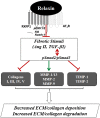Anti-fibrotic actions of relaxin
- PMID: 27250825
- PMCID: PMC5406285
- DOI: 10.1111/bph.13529
Anti-fibrotic actions of relaxin
Erratum in
-
Correction.Br J Pharmacol. 2017 Dec;174(24):4836. doi: 10.1111/bph.14111. Br J Pharmacol. 2017. PMID: 29235105 Free PMC article. No abstract available.
Abstract
Fibrosis refers to the hardening or scarring of tissues that usually results from aberrant wound healing in response to organ injury, and its manifestations in various organs have collectively been estimated to contribute to around 45-50% of deaths in the Western world. Despite this, there is currently no effective cure for the tissue structural and functional damage induced by fibrosis-related disorders. Relaxin meets several criteria of an effective anti-fibrotic based on its specific ability to inhibit pro-fibrotic cytokine and/or growth factor-mediated, but not normal/unstimulated, fibroblast proliferation, differentiation and matrix production. Furthermore, relaxin augments matrix degradation through its ability to up-regulate the release and activation of various matrix-degrading matrix metalloproteinases and/or being able to down-regulate tissue inhibitor of metalloproteinase activity. Relaxin can also indirectly suppress fibrosis through its other well-known (anti-inflammatory, antioxidant, anti-hypertrophic, anti-apoptotic, angiogenic, wound healing and vasodilator) properties. This review will outline the organ-specific and general anti-fibrotic significance of exogenously administered relaxin and its mechanisms of action that have been documented in various non-reproductive organs such as the cardiovascular system, kidney, lung, liver, skin and tendons. In addition, it will outline the influence of sex on relaxin's anti-fibrotic actions, highlighting its potential as an emerging anti-fibrotic therapeutic.
Linked articles: This article is part of a themed section on Recent Progress in the Understanding of Relaxin Family Peptides and their Receptors. To view the other articles in this section visit http://onlinelibrary.wiley.com/doi/10.1111/bph.v174.10/issuetoc.
© 2016 The British Pharmacological Society.
Figures

References
Publication types
MeSH terms
Substances
Grants and funding
LinkOut - more resources
Full Text Sources
Other Literature Sources

